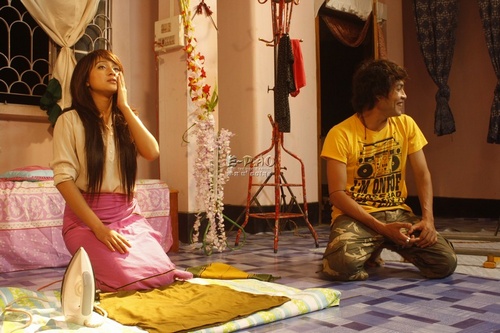Popularizing the mundanity: Yo and Dashanihe
Dr. Ksh. Imokanta Singh *

A scene from Yaiskulgi Pakhang Angaoba
Yo Sanatombi starts perspiring and his heart palpitating like cheetah seeing the ladies gobbling up whatever is ordered, chow mein, ice-cream etc., Kaboklei Inaocha gives a long sigh da..sha...ni..he. But Yo Sanatombi would not show his miserable state, but wears a furtive smile to his muse of Keisamthong because he does not want to lose his yo image and because he is a pakhang angaoba from Yaiskul who desperately wants to say airi nangta jenne.
As we all know this film called 'Yaiskulgi Pakhang Angaoba' and particularly the catch words yo and dashanihe have captured the imagination of the people of Manipur in general and youth in particular. Here I will not reiterate the obvious i.e. the content, the context and the effect of this film on the inter-community relationship between Meiteis and Kabuis.
I will take a cue from this film and expand the horizon of popular consciousness. I would not have written this piece if the effect of this film had been negligible, if my little daughter of three years had not insisted on playing nakhoi khungi thongandani ... time and again and crooning the same with Yo Sanatombi and Majaru, and if she had not said dashanihe in the most unimaginable situations, at least from her. So youth sub-culture might have to expand to include the infant culture in this case.
The origin of the word or slang yo may be traced back in the 1970s amongst the Italian and African American communities settled down in Philadelphia, Pennsylvania. The contexts may range from being a word for addressing, greeting, exclamation, grabbing attention etc., mainly popularized by rap musicians. Here in Manipur we do not give much insight into the meaning of the word.
More than the word, it is the attitude revealed through one's gesture, hair style (spiky one), communication manner, sartorial styles, eating habits, so and so forth. But it is a holistic frame of a person which conveys the true essence of yo-ness. The word bears the baggage of being urbane, shabbily chic and 'counter-culture' i.e. as an antithesis of being polish and conformist.
Thanks to 'Yaiskulgi Pakhang Angaoba' the two words yo and dashanihe have become an indispensable ingredient of our daily menu of spoken language, heard in almost all the possible places where there is any communication, be it on the streets, hotels, schools, buses and even in the examination centres (how apt it is to hear dashanihe from an examinee when he is stuck at an unexpected question) and at the venue of the announcement of the results of the recently concluded general election.
They are now the flavour of the moment. This is a perfect example of the ingenuity of popular culture. Popular culture, by the way, can be understood in many ways but here for the benefit of this article it may be taken as an ecstatic marriage between texts (popular fiction, television, pop music etc.) and lived experiences, in our present case the youth sub-culture.
If the former is the originating agent, the latter is the disseminating agent. The former cannot be just popular without the unconditional allegiance of the latter, serving also as a popularizing agent. The latter is responsible for creating an epom, literally, amongst both the spirited and de-spirited (they will surely be caught by the wave sooner than later) population.
The combined force of psychology and physiology of the popular culture is such that it can transform the mundane into a celebrity with all its intrigues of striking the weak spots of the masses, within a short span of time. For instance, had there been no Jayenta, the term and concept called tapta would have remained slumbered just as a mythological figure, occasionally awaken by some mothers here and there.
Here the much popular song of pahari resounds in me ... ubidraba fajaba fajarubagi kari kanei, khangbidraba nungshiba nungshirubagi kari kanari. What is needed is a right mentor to rediscover them in a right time and place. In fact the words like yo and dashanihe were already in circulation before this film. Before this they were just running in the stream of mundanity but now it is for all of us to see where they are.
Again the shrewdness of popular culture is so sharp that we are compelled to question, 'were there any such words as yo and dashanihe before Yaiskulgi Pakhang Angaoba?' Its 'chlorophomic' effect numbs our sense and seemingly nullifies the prior entries of such words in the register of consciousness. Sometimes we feel as if the two words are the invention of this film.
Not just them, there are other such cases, most identifiable among them would be the popular culture of 'remix'. Instead of delving into the unlimited remixed songs of the old melodious and hit Hindi film songs (only some are able to run, others had slumped into the dark gorge of time along with their 'sexy' hip gyrating item girls), let me take some from our own.
One of the most memorable seems to be 'nuja kanagi chenglouno...' re-sung with catchy beats and husky voice by Tijendra to arouse the young nerves (including me who keeps it as a safe song at the time of 'emergency performance'). Most among the younger generation felt that it was Tijendra's original version giving least attention to Pahari, the original singer. Here the true meaning of 're-discover' comes aloud with vibrant radiance.
It does not mean that the original version of Pahari was less appealing, it might have been a smashing hit during those old days. But a great deal of dust had mounted in the streets of Imphal that Pahari was hidden only to be re-discovered. If the re-discovery was done for the sake of re-discovery by bringing in some western and local music by some mushrooming very untalented people who call themselves 'singers', it would, probably, turn out to be a sort of 'confusion music' instead of 'fusion music'.
What is most important for re-discovery is what, when and how of the text. 'What' may count the influence of the form and content of the original text. 'When' may be the judicious selection of time. 'How' of the re-discovery becomes most important. It needs charm, nay charisma, and talent of the re-discoverer (he/she may be the performer, singer, musician, choreographer etc.) and exciting narrative style which may include striking plots, catchy dialogues, matching costumes etc. This is simply why Kaboklei Inaocha seems to have taken the centre stage from R.K. Sanatombi, with his inimitable style of rendering dashanihe and his yo-ness.
Here it may be reminded that the life spans of most of the slangs are short. They are like typhoon sweeping and creating its own way and niche and then calming down. Again they are like 'meat masala' enriching the taste of the informal language. One striking slang can capture the mood of the talk more than what a picture or a long descriptive purist sentence does.
One full-throated 'b***s**t' is sufficient to express one's dejection in just an instant. It is probably the case in all the known languages of humanity. I know a friend who does not feel that a sentence is perfect without one or two 'Be***Ch***'. It gives him a sense of satisfaction though it may not sound so to some of the listeners. The speakers may not necessarily mean what the slangs literally say but they use them to express the volume of emotion they have at the moment.
Sincerely, how many of us know the literal meaning of dashanihe? But it gives us great joy in expressing our sorrow with this slang. We are grateful to Kaboklei Inaocha for making our sentences and emotions overflowing with dashanihe and also for popularizing the popular culture. But, but, it is with a sense of urgency that I am writing this piece lest 'dashanihe' and 'yo' become obsolete and mundane (god forbid!), since slangs dwell in the ephemeral realm, and take rest in the green room waiting for someone to take them onstage.
See Photo Gallery for "Yaiskulgee Pakhang Angaoba" - Behind the Scene :: Part 1
See Photo Gallery for "Yaiskulgee Pakhang Angaoba" - Behind the Scene :: Part 2
